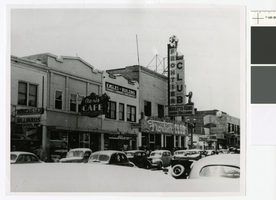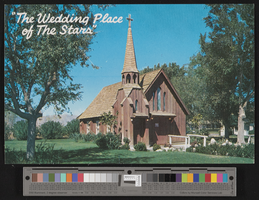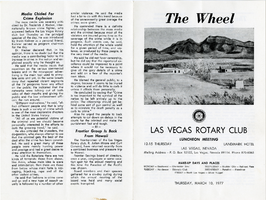Search the Special Collections and Archives Portal
Search Results

Transcript of interview with Marshall Mack Dawson by Robert Maichle, November 1, 1979
Date
Archival Collection
Description
On November 1, 1979, Robert Maichle interviewed Marshall Mack Dawson (born 1938 in Las Vegas, Nevada) about his experiences living in Las Vegas. Dawson first talks about his early education, his family, and the Old Las Vegas Mormon Fort. He then describes the changes he has noticed over time, the atomic testing, the Helldorado parades, Red Rock, the development of the Strip, and the changes in the Downtown area. Dawson also discusses some of his work for Nevada Power, the early movie theaters, his opinions on journalism, and various other topics.
Text

Transcript of interview with Millicent Rosen by Barbara Tabach, June 23, 2015
Date
Archival Collection
Description
Until her passing in 2017, Millicent (Siegel) Rosen was the living link to Benjamin “Bugsy” Siegel, one of Las Vegas’ most notorious links to the Jewish mob. A steadfastly independent woman herself, Millicent recalls Benjamin as a loving father to her and her younger sister. She is proud of his status as a Las Vegas visionary, though she affixes a footnote that the city of today might not be to his liking. She includes a few anecdotes about common names of the early days, including Meyer Lansky who walked her down the aisle when she married Jack Rosen. They had three children: Benjamin, Cindy, and Wendy. Millicent moved to Las Vegas to be with her daughter and her family in about 2000 and cherished her role as a grandmother. Always an artist at heart, Millicent once painted canvases for needlepoint and in 2015 promoted her clothing line.
Text

Transcript of interviews with Al Levy by Cheryl Caples, February 23, 1979 and by Martha Zehnder, March 8, 1981
Date
Archival Collection
Description
Part I: Interview with Al Levy by Cheryl Caples on February 23, 1979. At the time of this interview, Levy was serving on the city commission (now the Las Vegas City Council). He talks about growing up in Las Vegas and attending Las Vegas Grammar School (Fifth Street School) and Las Vegas High School. He mentions the Helldorado events, recreational activities, and raising a family in Las Vegas. Part II: Interview with Al Levy by Martha Zehnder on March 8, 1981. Levy recalls much of the same information as the previous interview, and again talks about his schooling and attending the University of Southern California. He returned to Las Vegas to assist his father with his grocery stores. Levy talks about the polio epidemic as the reason that children were not allowed to swim at public or hotel pools. He discusses his real estate firm, Levy Realty Company, his involvement in the community and the Jaycees (Junior Chamber of Commerce), and the booming hotel industry. Levy also discusses some city leaders he's known, including Mayor Gragson. He talks about his Jewish faith and having to go to Los Angeles to train for his bar mitzvah because there were no rabbis living in Las Vegas.
Text

Transcript of interview with Colleen Gregory by Tim Waters, April 6 & 7, 1976
Date
Archival Collection
Description
On April 6 and 7, 1976, Tim Waters interviewed Colleen Gregory (born 1928 in Santa Clara, Utah) about her life in Southern Nevada. Gregory first talks about her original move to Las Vegas, her early education, school activities, and her college education. She also talks about the first banks, Helldorado, the atomic testing, and environmental changes. Other topics covered include Howard Hughes, Western-style influences, first properties on the Strip, World War II, racial prejudice, and changes she has noticed during her career in banking.
Text

Photograph of the south side of Fremont Street (Las Vegas), summer of 1942
Date
Archival Collection
Description
A view of the south side of Fremont Street showing the Oasis Cafe, Fraternal Order of the Eagles (F.O.E.) building, and the Frontier Club. This is the present location of the Golden Nugget. Handwritten text on original: "South side of Fremont Street between First & Second. Present location of Golden Nugget. Taken in summer of 1942. Howard J Werner"'
Site Name: Fremont Street
Address: Fremont street, Las Vegas, NV
Image

Mary Healy, right, enjoying a meal with two unidentified people: photographic print
Date
Archival Collection
Description
Image

Postcard of the Little Church of the West, Las Vegas (Nev.), 1950s
Date
Archival Collection
Description
Image

The Wheel Las Vegas Rotary Club newsletter, March 10, 1977
Date
Archival Collection
Description
Text
Kovell, Hank, 1921-2002
Publicity agent Hank Kovell worked for the Frontier and Fremont Hotels in Las Vegas, Nevada and owned his own firm, Kovell Incorporated, which did marketing for numerous hotels on the Strip and downtown from 1964 to 1969. He organized local merchants to produce the first free coupon book that became a staple of the downtown gaming industry. He authored the book
Person
Financial records, 1962, 1967, 1972, 1981-1982, 1991-1992
Level of Description
Archival Collection
Collection Name: Frontier Girl Scouts Records
Box/Folder: Box 40
Archival Component
